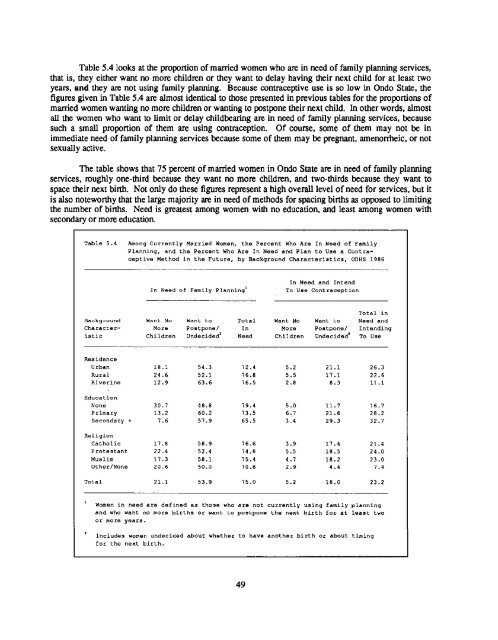Final Report (PDF, 2132K) - Measure DHS
Final Report (PDF, 2132K) - Measure DHS
Final Report (PDF, 2132K) - Measure DHS
Create successful ePaper yourself
Turn your PDF publications into a flip-book with our unique Google optimized e-Paper software.
Table 5.4 looks at the proportion of married women who are in need of family planning services,that is, they either want no more children or they want to delay having their next child for at least twoyears, and they are not using family planning. Because contraceptive use is so low in Ondo State, thefigures given in Table 5.4 are almost identical to those presented in previous tables for the proportions ofmarried women wanting no more children or wanting to postpone their next child. In other words, almostall the women who want to limit or delay childbearing are in need of family planning services, becausesuch a small proportion of them are using contraception. Of course, some of them may not be inimmediate need of family planning services because some of them may be pregnant, amenorrheic, or notsexually active.The table shows that 75 percent of married women in Ondo State are in need of family planningservices, roughly one-third because they want no more children, and two-thirds because they want tospace their next birth. Not only do these figures represent a high overall level of need for services, but itis also noteworthy that the large majority are in need of methods for spacing births as opposed to limitingthe number of births. Need is greatest among women with no education, and least among women withsecondary or more education.Table 5.4Among Currently Married Women, the Percent Who Are In Need of FamilyPlanning, and the Percent Who Are In Need and Plan to Use a ContraceptiveMethod in the Future, by Background Characteristics, O<strong>DHS</strong> 1986In Need of Family Planning IIn Need and IntendTo Use ContraceptionTotal inBackground Want No Want to Total Want No Want to Need andCharacter- More Postpone/ In More Postpone/ Intendingistic Children Undecided 2 Need Children Undecided' To UseResidenceUrban 18.1 54.3 72.4 5.2 21.1 26.3Rural 24.6 52.1 76.8 5.5 17.1 22.6Riverine 12.9 63.6 76.5 2.8 8,3 ii.IEducationNone 30.7 48.8 79.4 5.0 11.7 16.7Primary 13.2 60.2 73.5 6.7 21.6 28.2Secondary + 7.6 57.9 65.5 3.4 29.3 32.7ReligionCatholic 17.8 58.9 76.6 3.9 17.4 21.4Protestant 22.4 52.4 74.8 5.5 18.5 24.0Muslim 17.3 58.1 75.4 4.7 18.2 23.0Other/None 20.6 50.0 70.6 2.9 4.4 7.4Total 21,1 53.9 75.0 5.2 18.0 23.2Women in need are defined as those who are not currently using family planningand who want no more births or want to postpone the next birth for at least twoor more years.Includes women undecided about whether to have another birth or about timingfor the next birth.49








![Obtaining Informed Consent for HIV Testing [QRS4] - Measure DHS](https://img.yumpu.com/49850117/1/190x245/obtaining-informed-consent-for-hiv-testing-qrs4-measure-dhs.jpg?quality=85)







